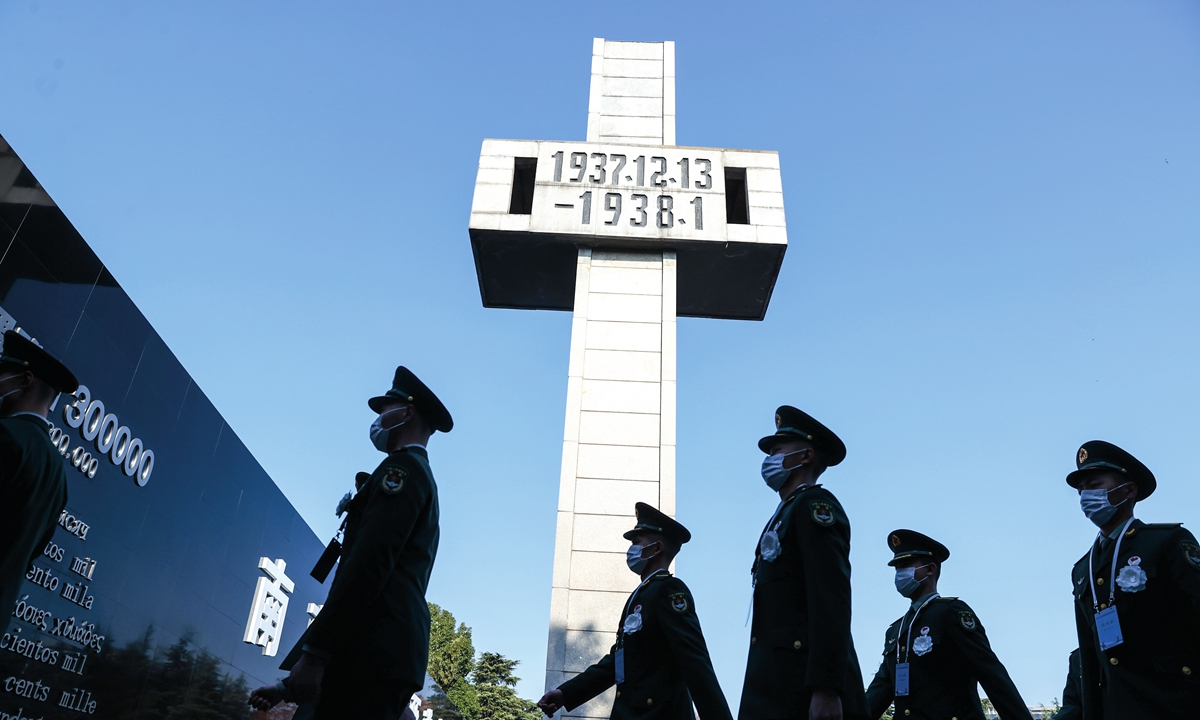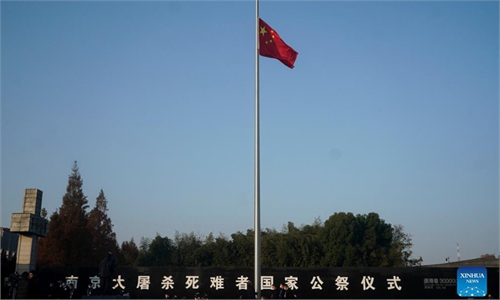No evidence to support Nanjing Massacre has 300,000 victims? Such ignorance! The number came from verdict of the Far East and the Nanjing War Crimes Tribunal: former curator

A ceremony is held to commemorate Nanjing Massacre victims on December 13, 2021, the eighth National Memorial Day for the more than 300,000 victims who were brutally killed by Japanese troops after the city was captured by Japanese invaders in 1937. Memorial events were held across China to remember the day. Photo: VCG
The controversy over a teacher at a vocational college in Shanghai, who said in class that casualty figures in the notorious Nanjing Massacre are not supported by real data, has continued since she was fired, with some netizens reposting the full video and trying to defend her. However, more netizens and experts have produced historical materials that show the teacher was wrong.
On Thursday night, Shanghai Aurora College said in a statement that Song Gengyi, the teacher who made the wrong remarks, has been fired according to the college's regulations, as these remarks caused a major teaching incident and an adverse social impact.
The punishment came after a video of Song giving a lecture and saying that the 300,000 victims of the Nanjing Massacre during the War of Resistance against Japanese Aggression (1931-45) were just "a compiled overview of Chinese historical novels" and there is no data to support the number.
The controversy did not die down after she was fired and on Friday some netizens posted a longer video, aiming to show that the previous video that went viral was maliciously cut to frame Song.
However, more netizens said that the longer video could not be used to defend Song, instead, it exposed more mistakes that Song made and showed her ignorance of history.
"Trying to deny the Nanjing Massacre shows the teacher lacks basic knowledge of history and it also shows ignorance that has hurt the feelings of the Chinese people," Zhu Chengshan, former curator of the Nanjing Massacre Memorial Hall and a research fellow with the Institute of Nanjing Massacre History and International Peace, told the Global Times on Friday.
Zhu noted that the number of 300,000 victims came from the historical judgments of the International Military Tribunal for the Far East and the Nanjing War Crimes Tribunal after WWII, which is legitimate. Numerous historical records and evidence have been kept in the Second Historical Archives of China and Nanjing Archives Hall. The Document of the Nanjing Massacre, which is compiled based on these materials, was enlisted into the Memory of the World Program in 2015 and has been widely acknowledged by the international community.
The verdict of the International Military Tribunal for the Far East, which was set up in January 1946, showed that in the first six weeks after the Japanese invasion of Nanjing, the number of civilians slaughtered and captured in and near Nanjing exceeded 200,000. This number did not include those who were cast into the Yangtze River or buried.
After lots of investigations, the Nanjing War Crimes Tribunal, which started in February 1946, gave the verdict that the Japanese invaders committed 28 group massacres with more than 190,000 people dying and the bodies buried by charity organizations exceeding 150,000. Giving the verdict that there were more than 300,000 victims in the Nanjing Massacre shows that the number of 300,000 is the lower limit. Related materials have been kept in the Second Historical Archives of China.
Zhu said that after the Nanjing Massacre, charity organizations helped to bury the bodies. Local residents who could not bear to see the bodies of their compatriots being cast into the rivers helped to bury victims and a large number of records on this have been maintained in the Nanjing Archives Hall. "This is the iron evidence for the Japanese crimes."
In the full video clip of Song's lecture, the teacher questioned the number of 300,000, saying there is no name or identity number for each victim. However, public information showed that it was not until April 6, 1984, that Chinese people began to have certificates for identity. Previously, they needed introduction letters or household registration as an identity certificate.
Song's remarks showed her ignorance since the current system on identity number did not start when the Nanjing Massacre happened. "How could the number of victims be calculated by identity number?" asked Zhu.
"We have acquired a large number of original records on the buried bodies. We calculated the males, females, children and seniors and livestock and the sites where these bodies were buried, including Yangyangying, Beijige and the Zhengjue Temple and the Pude Temple. We have detailed and abundant records. But at the same time, it is not possible to get every victim's name," said Zhu.
The expert noted that it is also impossible to accurately figure out the name of each victim in the Auschwitz Concentration Camp or in the Hiroshima bombing. "Anyone who questioned the number of victims due to having no specific name or identity cards either has the wrong stance or a mentality problem," said Zhu.
The video of Song's lecture went viral on Tuesday, just one day after China held a nationwide commemoration for the victims of the 1937 Nanjing Massacre.
On Wednesday, the Memorial Hall of the Victims of the Nanjing Massacre by Japanese Invaders released the written judgment of Tani Hisao, one of the principal criminals in the massacre, on its official Sina Weibo account. It said that while Hisao's troops were stationed in Nanjing, more than 190,000 residents were slaughtered and burned in different sites in the city. Massacres happened around the city and more than 150,000 bodies were buried by charity organizations.
During the long video, Song also linked the attitude of the Japanese government toward the Beijing Winter Olympic Games with the nationwide commemoration for the victims of the 1937 Nanjing Massacre on December 13.
"This is ridiculous! What's the relationship between the national commemoration and the Beijing Winter Olympics?" Zhu asked. He noted that on December 13, 1994, Nanjing held the first commemoration for the victims. Since the first national commemoration on December 13, 2014, China has held eight such commemorations, which has nothing to do with the Olympics.
Zhu also criticized Song's remarks calling for students to rethink how the war came about. Zhu said that the truth is that Japan invaded China and slaughtered Chinese people. The Chinese nation should work hard to ensure that the tragedy is not repeated - this is what we need to rethink about the war, Zhu noted.
Many citizens also criticized Song and those who wanted to whitewash her remarks. They commented that Song's lesson had nothing to do with academic discussion but was simply about consciousness and the principles of right and wrong.
Some also criticized the student who recorded the video and posted it online.
Zhu said that the student should be encouraged. "Even the students know the basic history. The teacher, however, stood with the Japanese right wing to make irresponsible and wrong remarks. Such a teacher has no sense of right and wrong and deserves no respect from the students and is not qualified to stand on the lecturing platform," Zhu said.


